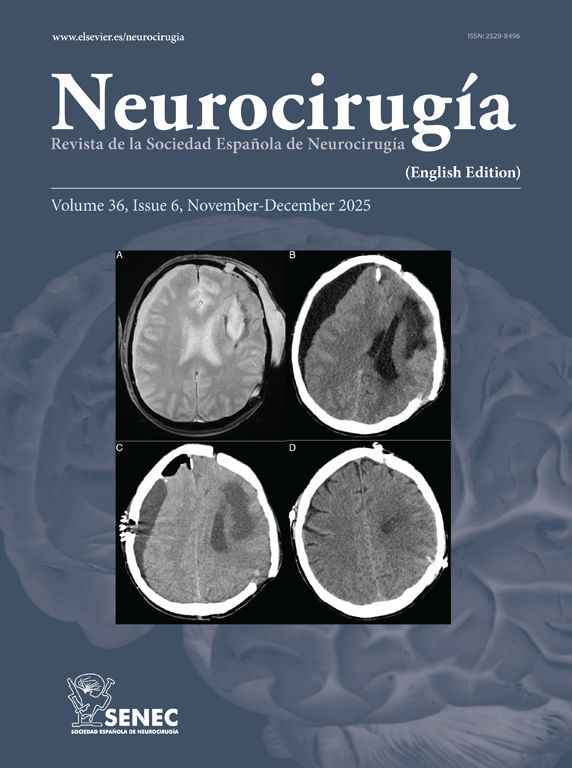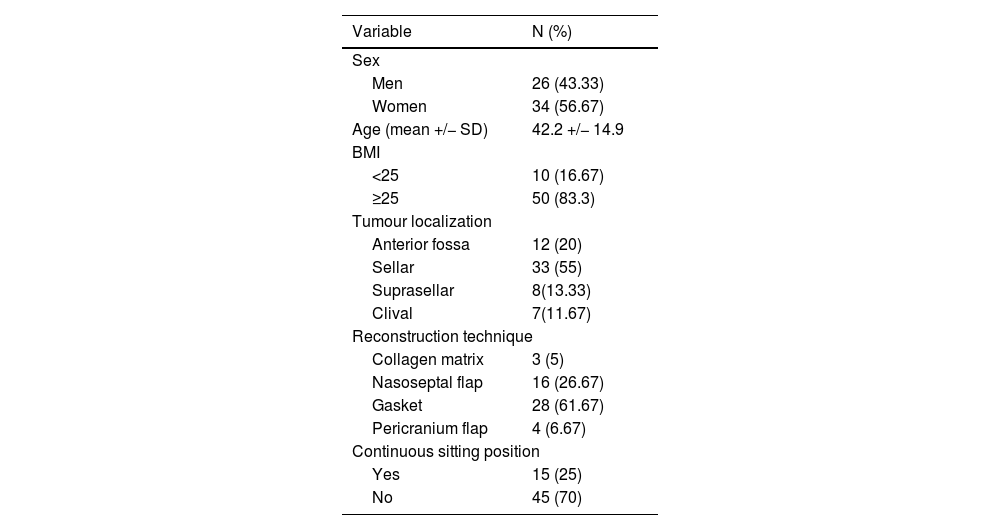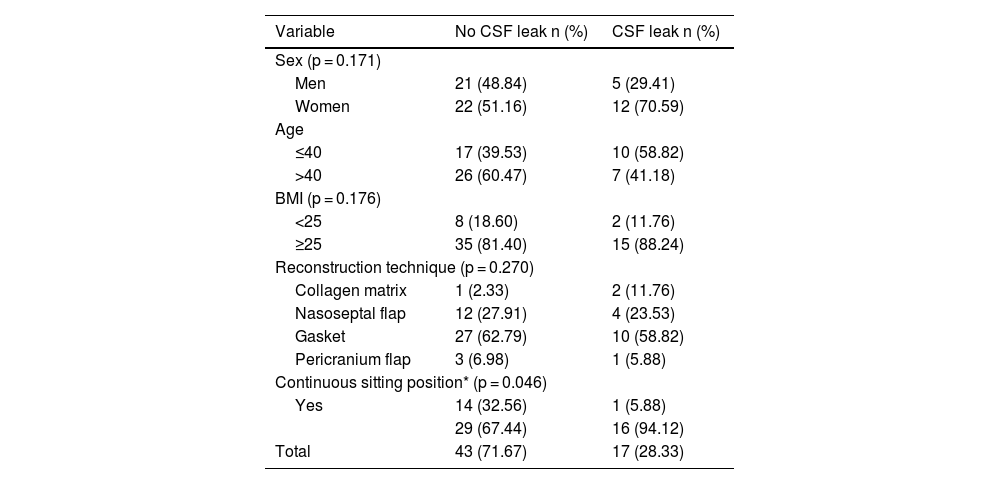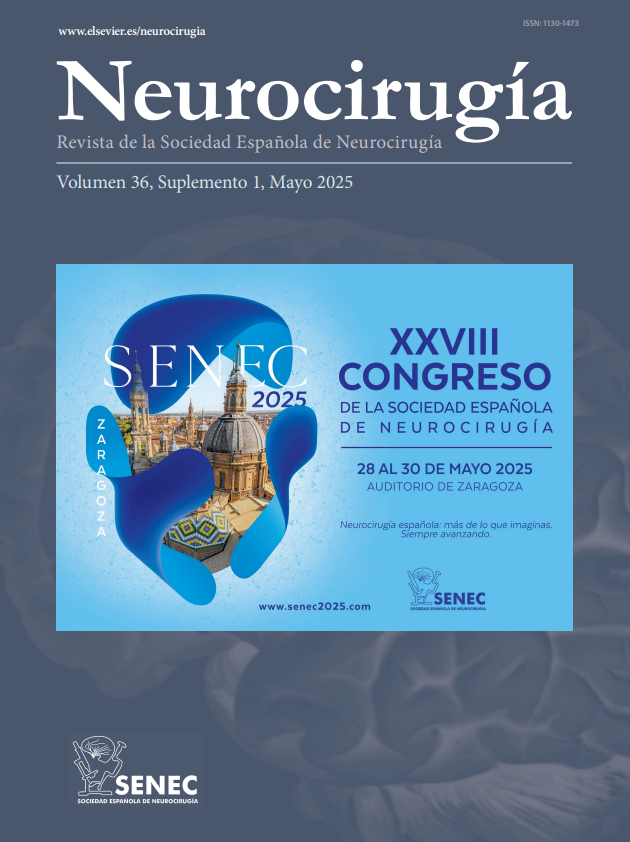In recent decades, endoscopic endonasal surgery for skull base tumours has modified the way in which this region is approached. One of the most feared complications is the cerebrospinal fluid leak. It has been shown in different publications about CSF physiology that changes in the position modify the pressure of the CSF (pCSF). With this background, it is proposed as a viable, noninvasive, and very low-risk option, the continuous sitting position in patients during their hospital stay after endoscopic endonasal surgery as an adjuvant intervention to reduce the risk of CSF leak in patients considered to be at high risk. The objective is to demonstrate that the continuous sitting position in the postoperative period is a useful adjuvant intervention for the prevention of CSF leak in endoscopic endonasal surgery.
MethodsThis is a retrospective, observational, cross-sectional, comparative study. It included patients over 18 years of either sex, intervened by endoscopic endonasal surgery with intraoperative CSF leak observed and with advanced reconstruction technique realized. A continuous sitting position (between 70 ° and 90 °) was considered when the patient remained in this position from the immediate postoperative period until the hospital discharge.
ResultsA total of 60 patients were included. No statistically significant difference was found on all the variables studied, except when patients were stratified into sitting and non-sitting patients (p = 0.045). OR of 0.12 (95% CI 0.002–1.03) was observed. In the sitting group, only 1 patient (6.67%) had CSF leak, which was resolved with non-surgical treatment. The average length of hospital stay was 18 days (7–38) for sitting patients and 14 days (5–80) for non-sitting patients, with statistical significance stablished by the dispersion of the data (p = 0.023).
ConclusionsThe continuous sitting position during the immediate postoperative period is an intervention that shows a decrease in the risk of CSF leak in patients intervened by endoscopic endonasal approach, included extended routes.
En las últimas décadas, la cirugía endoscópica endonasal en tumores de base del cráneo ha modificado la forma de abordar esta región. Una de las complicaciones más temidas es la fístula de líquido cefalorraquídeo. Se ha demostrado en diferentes publicaciones sobre la fisiología del LCR que los cambios en la posición modifican la presión de LCR. Con estos antecedentes, se propone como una opción viable, no invasiva y de bajo riesgo, la posición sedente continua en pacientes durante su estancia hospitalaria tras cirugía endoscópica endonasal como intervención para reducir el riesgo de fuga de LCR en pacientes considerados de alto riesgo. El objetivo es demostrar que la posición sedente continua en el postoperatorio es una intervención adyuvante útil para la prevención de la fístula de LCR en la cirugía endoscópica endonasal.
MétodosSe trata de un estudio retrospectivo, observacional, transversal y comparativo. Se incluyeron pacientes mayores de 18 años de ambos sexos, operados mediante cirugía endoscópica endonasal con fístula de LCR observada intraoperatoriamente y con técnica de reconstrucción avanzada realizada. Se consideró posición sedestación continua (entre 70 ° y 90 °) cuando el paciente permaneció en esta posición desde el postoperatorio inmediato hasta el alta hospitalaria.
ResultadosSe incluyeron 60 pacientes. No se encontró diferencia estadísticamente significativa para las variables estudiadas, excepto cuando se estratificó a los pacientes en pacientes sedentes y no sedentes (p = 0,045). Se observó un OR de 0,12 (IC 95% 0,002−1,03). Del grupo sedente sólo 1 paciente (6,67%) presentó fístula de LCR, que se resolvió con tratamiento no quirúrgico. La estancia media hospitalaria fue de 18 días (7–38) para los pacientes sedentes y de 14 días (5–80) para los no sedentes estableciéndose la significación estadística por la dispersión de los datos (p = 0,023).
ConclusionesLa sedestación continua durante el postoperatorio inmediato es una intervención que demuestra una disminución del riesgo de fístula de LCR en pacientes intervenidos por vía endoscópica endonasal con abordajes extendidos a la base del cráneo.
Article

If it is the first time you have accessed you can obtain your credentials by contacting Elsevier Spain in suscripciones@elsevier.com or by calling our Customer Service at902 88 87 40 if you are calling from Spain or at +34 932 418 800 (from 9 to 18h., GMT + 1) if you are calling outside of Spain.
If you already have your login data, please click here .
If you have forgotten your password you can you can recover it by clicking here and selecting the option ¿I have forgotten my password¿.








